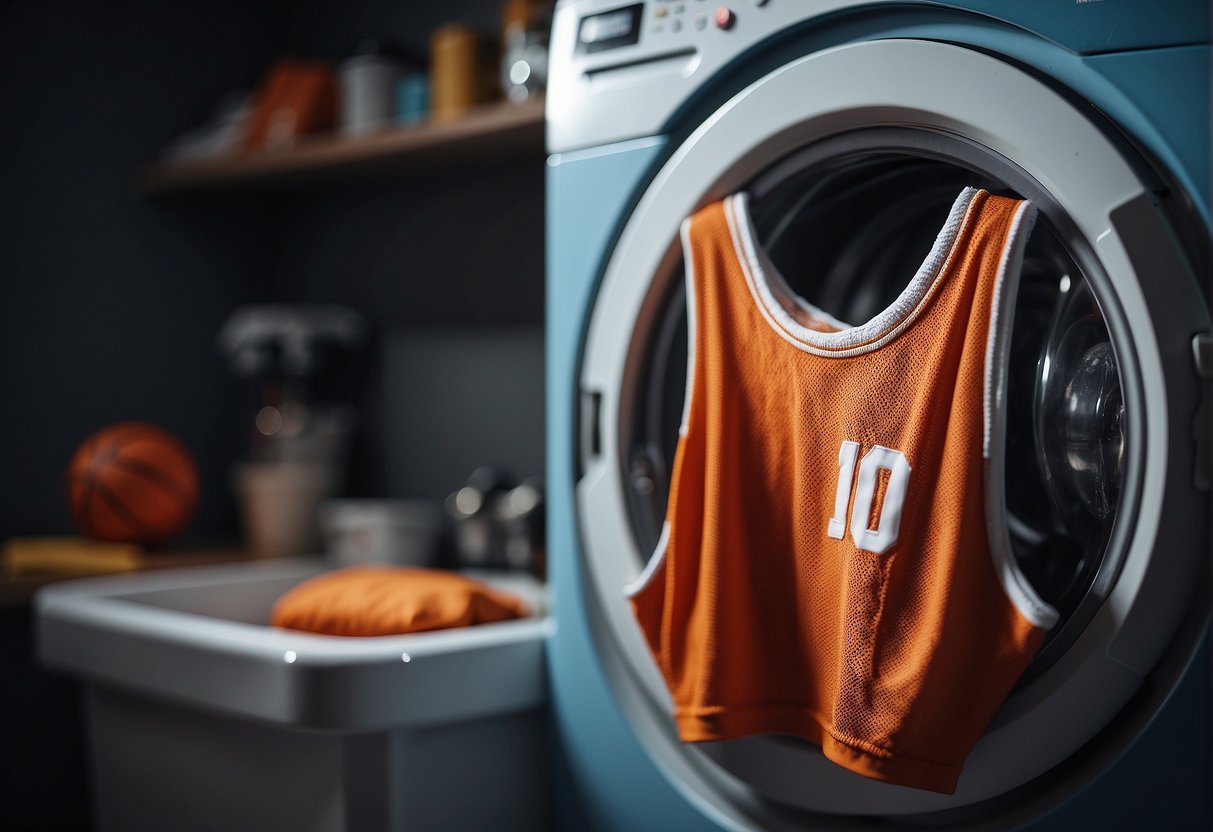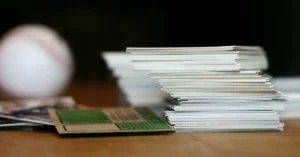Maintain the pristine condition of your basketball jersey with my essential tips on how to wash a basketball jersey.
Rely on my expert advice for stain removal and proper care techniques to keep your jersey looking fresh and vibrant.
Understanding Your Basketball Jersey
Before you take any steps to clean your basketball jersey, it’s essential to understand what it’s made of and the specific care instructions provided by the manufacturer. This knowledge ensures the longevity and preservation of the quality of your jersey.
Materials and Quality
Your basketball jersey is likely made of high-quality synthetic materials such as polyester, mesh, or a blend, specifically designed to provide breathability and moisture-wicking properties. These materials are selected for their durability and ability to withstand the rigor of the sport while maintaining comfort during play. To confirm the material type, check the tag located inside your jersey.
- Common Materials Used:
- Polyester
- Mesh (Polyester-based)
- Nylon
Sports Jersey Care Labels
Each sports jersey comes with a care label that provides crucial instructions on how to maintain it properly. You’ll find this label sewn into the inside seam of your jersey. The care label will indicate the appropriate washing and drying methods, which typically include the following:
- Washing Instructions:
- Temperature: Use cold water to prevent shrinkage and color fading.
- Cycle: Gentle or sports cycle to protect the fabric.
- Drying Instructions:
- Tumble dry low or air dry to protect the integrity of the material.
Preparation for Washing
Before you start, it’s essential to know that proper preparation can significantly enhance the effectiveness of washing your basketball jersey. This includes sorting your jersey based on color and material and pre-treating stubborn stains.

Sorting and Inspection
You’ll want to begin by sorting your jerseys, separating colored jerseys from whites to avoid color bleed. This ensures that your whites stay crisp and your colors vibrant. Inspect each jersey for specific stains and areas requiring extra attention, like sweat marks or grass stains.
- Colors: Keep them separate from whites to avoid dye transfer.
- Materials: Mesh jerseys require gentler handling compared to cotton ones.
Pre-Treatment for Stains
When you encounter tough stains such as mustard, blood, or heavy sweat, pre-treating is key to effectively removing them. Dab the stained area with a mild, color-safe detergent and gently work it into the fabric. Cold water is essential for blood stains, as hot water can set the stain.
- Grass Stains: Pre-treat with a mixture of detergent and water.
- Mustard/Blood Stains: Apply a small amount of gentle detergent directly to the stain and lightly rub.
Quick tip on blood stain removal: cold water is your friend here — it helps to prevent it from setting into the fabric too profoundly.
Washing the Basketball Jersey

Washing Machine Settings
When preparing to wash a basketball jersey in the washing machine, select a gentle cycle with cold water to avoid damaging the fabric. Setting your machine to low spin for the spin cycle will reduce the risk of stretching or warping your jersey.
Gentle Hand Washing Techniques
If you prefer to hand wash your jersey, fill a basin with cold water and add a teaspoon of mild detergent. Turn your jersey inside out to protect the decals and gently agitate the water with your hands. Avoid scrubbing to prevent damage to the material.
Detergent Choices
Choosing the proper laundry detergent is crucial. Opt for a mild detergent that’s formulated for delicate fabrics. If you’re dealing with a tough stain, creating a solution with white vinegar and baking soda can be an effective pre-treat before the main wash.
Washing Tips for Color Preservation
To help maintain your jersey’s vibrant colors, always wash it with similar colors. This prevents dye transfer, which can occur when mixed with lighter garments. Additionally, avoid using fabric softeners as they can affect moisture-wicking properties and the overall look of your basketball jersey.
Drying and Post-Wash Care

After your basketball jersey has been washed, the drying process is just as essential to maintain its condition. Proper drying can prevent shrinkage, color fading, and material damage.
Here’s how to dry your jersey correctly and ensure it stays in top shape for your next game.
Air Drying the Right Way
Hang your jersey on a drying rack in a well-ventilated area away from direct sunlight to air dry. You can lay it flat on a clean towel if you don’t have a drying rack. Rearrange your jersey a few times to ensure it dries evenly and maintains its shape.
- Do
- Hang jerseys on a wide hanger.
- Straighten out wrinkles by hand to avoid using an iron later.
- Don’t
- Hang near heat sources or in direct sunlight.
- Wring out, which may cause fabric damage.
Avoiding Heat Damage
While using a tumble dryer may be tempting, high temperatures can cause your jersey to shrink or the prints to crack. If you must use a dryer, set it to a low-heat setting and remove the jersey while it’s still slightly damp to air dry completely.
- Caution:
- Avoid the dryer’s high heat cycles.
- Never use bleach or any harsh chemicals during the washing or drying process.
Remember, taking extra care during the drying stage makes all the difference in extending the life of your basketball jersey.
Ironing and Storage Solutions

Ensuring your basketball jersey is wrinkle-free and well-preserved keeps it looking professional and extends its lifespan. The proper techniques can make a significant difference in maintaining the texture and feel of your apparel.
Effective Ironing Methods
When it’s time to iron your basketball jersey, always check the care label first. Some jerseys are made from synthetic materials that can be damaged by high heat. For safe jerseys, set your iron to a low heat setting, typically indicated as ‘synthetic’ or ‘nylon.’
Lay the jersey flat on an ironing board, place a press cloth or clean towel over it to protect the print and fabric, and gently iron the jersey without applying too much pressure.
Proper Jersey Storage
After ironing, the key to preserving your jersey’s shape and feel is proper storage. Hang the jersey on a wide, padded clothes hanger to prevent creases or stretching. Avoid using wire hangers, as they can distort the shoulders of your jersey.
If drawer space is your preferred storage method, fold the jersey neatly; avoid overcrowding to keep the fabric’s texture intact. Cool, dry, and away from direct sunlight is the ideal environment to maintain the color and longevity of your apparel.
Special Considerations

When washing your basketball jersey, attention to odors and graphics is crucial. Harsh smells and sensitive decorations like numbers and logos require a gentle touch to maintain your jersey’s best condition.
Dealing with Tough Odors
To combat odors, a gentle pre-soak can do wonders before the main wash. For effective odor elimination without damaging the fabric, mix a solution of cold water and a mild detergent, ideally designed to treat synthetic fibers and combat germs. Submerge your jersey, focusing on the areas that tend to retain smells, such as the underarms.
For a more natural approach, white vinegar is excellent for neutralizing odors; a blend of water and vinegar can be pre-mixed and applied directly to the affected areas.
Handling Numbers and Logos
Be extra cautious around the numbers and logos on your jersey to avoid peeling or cracking. These decorations are often applied as heat transfers or patches and can be damaged if not treated properly.
When handling patches, it’s best to turn the jersey inside out before placing it in the wash. You should wash your jersey gently with cold water and let it air dry rather than using a tumble dryer, which may be too harsh on the adhesive and fabric.
Additional Tips and Tricks
When it comes to keeping your basketball jerseys clean and in top condition, a few extra steps can make a big difference. Whether dealing with a prized NBA jersey or a beloved local team uniform, proper care will extend its lifespan and keep it looking sharp on the court.
Fabric Softener Use
Please proceed with Caution: While it’s tempting to use fabric softener to keep jerseys soft, it’s usually not recommended. Fabric softener can build up and reduce the fabric’s ability to wick away moisture—which is essential for sports uniforms. Instead, when washing your basketball jersey, rinse it in cold water and skip the softener to maintain the jersey’s breathability and finish.
Basketball Jersey Longevity
Wash Inside Out: Always turn your jerseys inside out before washing. This protects the print and helps prevent pilling. Before you pre-soak or throw them in the wash, ensure all pockets are empty and any velcro is fastened to avoid snags.
Temperature Matters: Never wash your jerseys in hot water. Lukewarm or cold water is gentle on the fabric and keeps it from fading or shrinking. Stick to a delicate cycle to prevent excessive wear during the spin.
Drying Technique: Avoid a high heat setting in the dryer. Instead, air dry your jersey by laying it flat or hanging it up. This reduces the risk of heat damage and helps the jersey maintain its shape for years.
Troubleshooting Common Issues
Sometimes, even when you follow the standard care instructions, your basketball jersey can encounter issues such as shrinkage, misshaping, lint, or damage due to washer overload. Here’s how you can address these common laundry problems and keep your jersey in top condition.
Addressing Shrinkage and Misshaping
To prevent shrinkage or misshaping, always wash your jersey in cold water as heat can cause the material to contract. Check the washing instructions specific to your jersey’s material, usually found on the tag, and follow them closely. If misshaping has already occurred, gently reshape the jersey by hand while it is still damp and lay it flat to dry.
Removing Lint and Avoiding Overload
Removing lint can be as simple as using a lint roller or tape before washing. To avoid lint, wash your jersey with similar colors and materials that are less likely to shed. Regarding overload, your washer should be full but not packed; jerseys need room to move freely in the water. This prevents unnecessary friction that can create lint and cause damage to the fabric.
FAQ
How do you wash a jersey without ruining it?
For added protection, put the inside-out jersey in a garment bag before washing. Wash in cold water and on a gentle cycle. Washing in cold water helps prevent fading, shrinking or damage to letters or numbers on the jersey. Avoid using fabric softener.
Can you wash a jersey by itself?
With jerseys, you mustn’t wash them with any other apparel. The dye in these garments — especially blue jeans — can run and cause color streaks in your jersey. It would be best to wash white and black jerseys by themselves, separate from any other jersey colors.
Can NBA jerseys be put in the dryer?
When washing a sports jersey or other workout clothes, it’s best to use cold water and avoid the dryer. However, check the label inside the garment to ensure you’re taking the proper steps to wash and dry it.
If you enjoyed reading about the topic: How to wash basketball jersey, leave a comment and stay updated on Pinterest for more exciting basketball news.
Leave me a comment and make sure to also check out How to Break in Basketball Shoes.





